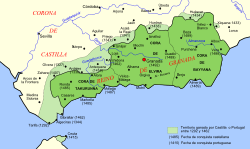King of Granada
| Emirate of Granada | ||||||||||
|
إمارة غرﻧﺎﻃﺔ Imarat Gharnāṭah |
||||||||||
| Tributary state of the Crown of Castile | ||||||||||
|
||||||||||
|
Motto Wa lā ghāliba illā-llāh (There is no victor but God) |
||||||||||
|
Territory of the Nasrid Kingdom
|
||||||||||
| Capital | Granada | |||||||||
| Languages | Official language: Classical Arabic Other languages: Andalusi Arabic, Mozarabic, Berber, Ladino |
|||||||||
| Religion | Majority religion: Islam Minority religions: Christianity (Roman Catholicism), Judaism |
|||||||||
| Government | Hereditary monarchy | |||||||||
| Sultan | ||||||||||
| • | 1238–1273 | Mohammed I ibn Nasr | ||||||||
| • | 1487–1492 | Muhammad XII | ||||||||
| Historical era | Late Middle Ages | |||||||||
| • | Established | 1230 | ||||||||
| • | Castilian conquest | 1492 | ||||||||
|
||||||||||
| Today part of |
|
|||||||||
The Emirate of Granada (Arabic: إمارة غرﻧﺎﻃﺔ, trans. Imarat Gharnāṭah), also known as the Nasrid Kingdom of Granada (Spanish: Reino Nazarí de Granada), was an emirate established in 1230 by Mohammed I ibn Nasr. After Prince Idris left Iberia to take the Almohad Caliphate leadership, the ambitious Mohammed I ibn Nasr established the last Muslim dynasty on the Iberian peninsula, the Nasrids. The Nasrid emirs were responsible for building the Alhambra palace complex as it is known today. By 1250, the Emirate was the last part of the Iberian peninsula held by the Muslims. Andalusian Arabic and the Berber language were the mother tongues of the majority of the Muslim population. For two more centuries, the region enjoyed considerable cultural and economic prosperity but also ongoing infightings over power. It was gradually conquered by the Crown of Castile and dissolved with the 1491 Treaty of Granada, ending the Granada War. In January 1492 Muhammad XII of Granada, the last Nasrid ruler of Granada, formally relinquished his sovereignty and surrendered his territories to Castile, eventually moving to Morocco in exile.
...
Wikipedia



